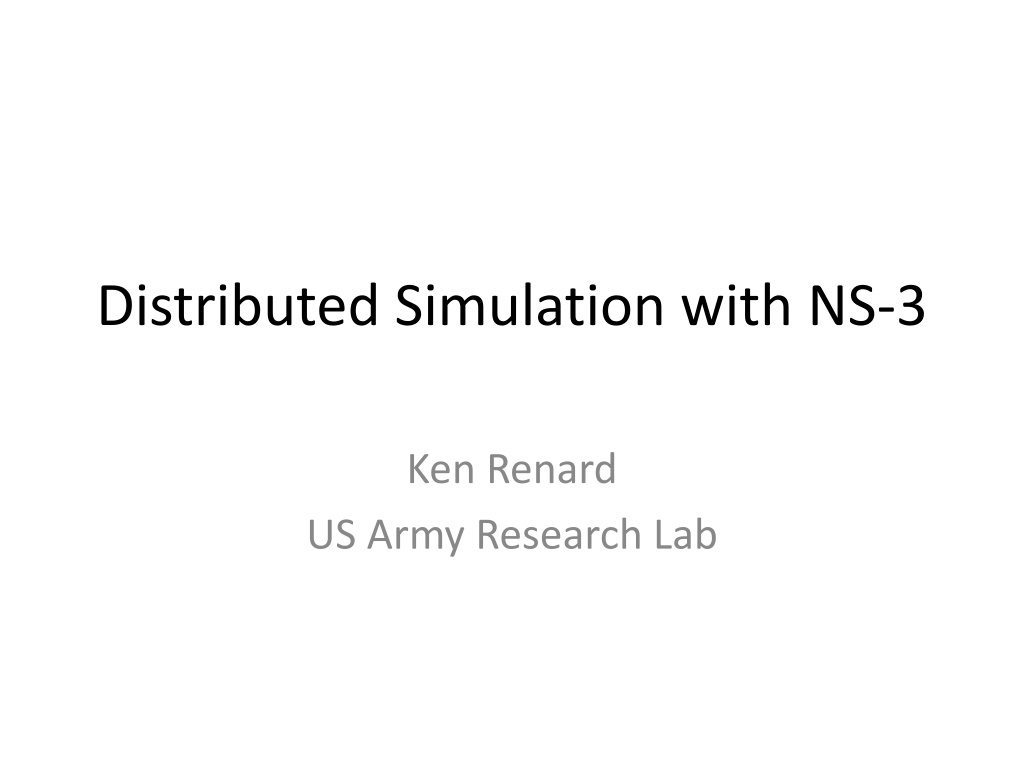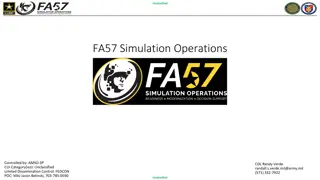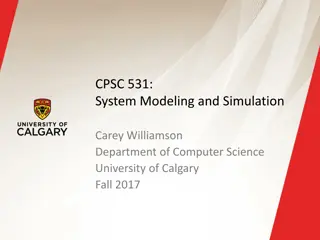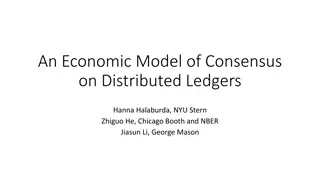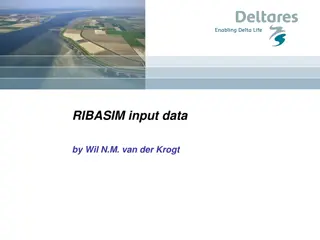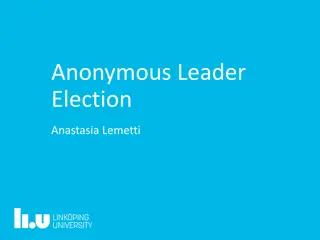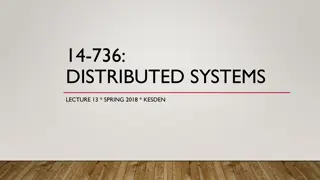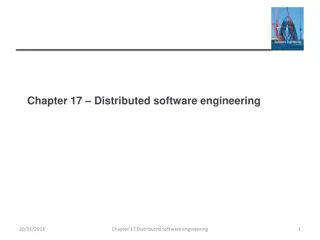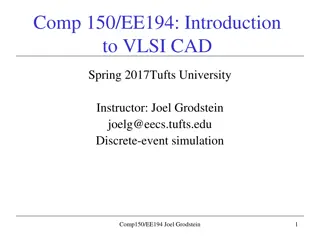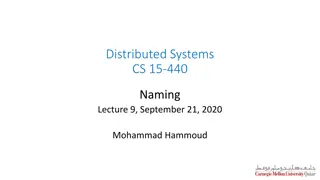Distributed Simulation with NS-3
Explore the world of distributed simulation with NS-3 as presented in "Distributed Simulation with NS-3" by Ken Renard from the US Army Research Lab. Get insights into the application of NS-3 in creating advanced simulations for military research and beyond. Dive into the details of distributed simulation techniques, their benefits, and practical implementations in real-world environments. This resource is a must-read for professionals and enthusiasts interested in simulation technologies.
Download Presentation

Please find below an Image/Link to download the presentation.
The content on the website is provided AS IS for your information and personal use only. It may not be sold, licensed, or shared on other websites without obtaining consent from the author.If you encounter any issues during the download, it is possible that the publisher has removed the file from their server.
You are allowed to download the files provided on this website for personal or commercial use, subject to the condition that they are used lawfully. All files are the property of their respective owners.
The content on the website is provided AS IS for your information and personal use only. It may not be sold, licensed, or shared on other websites without obtaining consent from the author.
E N D
Presentation Transcript
Distributed Simulation with NS-3 Ken Renard US Army Research Lab
Outline Introduction and Motivation for Distributed NS-3 Parallel Discrete Event Simulation MPI Concepts Distributed NS-3 Scheduler Limitations Example Code Walk-through Error Conditions Performance Considerations Advanced Topics
Introduction to Distributed NS-3 Distributed NS-3 is a scheduler that allows discrete events to be executed concurrently among multiple CPU cores Load and memory distribution Initially released in version 3.8 Implemented by George Riley and Josh Pelkey (Georgia Tech) Roots from: Parallel/Distributed ns (pdns) Georgia Tech Network Simulator (GTNetS) Performance Studies Performance of Distributed ns-3 Network Simulator , S. Nikolaev, P. Barnes, Jr., J. Brase, T. Canales, D. Jefferson, S. Smith, R. Soltz, P. Scheibel, SimuTools '13 A Performance and Scalability Evaluation of the NS-3 Distributed Scheduler , K. Renard, C. Peri, J. Clarke , SimuTools '12 360 Million Nodes
Motivation for High Performance, Scalable Network Simulation Reduce simulation run-time for large, complex network simulations Complex models require more CPU cycles and memory MANETs, robust radio devices More realistic application-layer models and traffic loading Load balancing among CPUs Potential to enable real-time performance for NS-3 emulation Enable larger simulated networks Distribute memory footprint to reduce swap usage Potential to reduce impact of N2problems such as global routing Allows network researchers to run multiple simulations and collect significant data
Discrete Event Simulation Execution of a series of time-ordered events Events can change the state of the model Create zero or more future events Simulation time advances based on when the next event occurs Instantaneously skip over time periods with no activity Time effectively stops during the processing of an event Events are executed in time order New events can be scheduled now or in the future New events cannot be scheduled in the past Events that are scheduled at the exact same time may be executed in any order To model a process that takes time to complete, schedule a series of events that happen at relative time offsets Start sending packet: set medium busy, schedule stop event Stop sending packet: set medium available, schedule receive events Exit when there are no more events are in the queue
Discrete Events and Timing for a Packet Transmission
Parallel Discrete Event Simulation (Conservative) By partitioning the model (network) into multiple pieces and map these pieces to Logical Processes, (LPs), each LP has its own set of events to process LPs are synchronized copies of NS3 running at the same time Try to distribute event load (processing load) equally among LPs Exploit parallelism in simulation At some point, we will need to schedule an event that will be executed on another LP Messages are passed between LPs to communicate event details and scheduling information Some form of time synchronization is required between LPs Must maintain causality cannot schedule an event in the past We need to communicate our event to a remote LP before that LP s simulation time passes our event time Events across LPs can execute independently and in parallel
Clock Synchronization in Conservative PDES We grant each LP a future time value such that no incoming events will occur before that time In the simple case, all LPs are granted the same time All LPs advance time in synchronized chunks The LP can now execute all events up to that time while preserving causality Incoming event requests are queued Incoming events will occur after the granted time The LP waits until it is granted additional time Even distribution of workload limits wasted time We want to maximize grant time such that a larger set of events can be computed in parallel
Lookahead & Grant Time Computation Lookahead value is the minimum amount of time that must elapse before an event at an LP can effect anything in another LP In network simulation we can use the propagation delay over a link/channel as the basis for lookahead Among a set of LPs, the maximum lookahead is the time of the next event, plus the minimum propagation delay among links that span LPs Compute Lower Bound Time Step (LBTS) Smallest timestamp of an event that can be delivered to another LP Select lowest LBTS over all LPs as global grant time All LPs advance to the same grant time before repeating Getting all LPs to communicate and determine lowest LBTS can be expensive O(n) to O(n2) messages, interconnect type, interconnect speed
Message Passing Interface (MPI) Distributed NS-3 uses MPI for communication and synchronization Message Passing Specification (not the library itself) Point-to-Point as well as collective communications Designed for high performance and scalability De-facto standard for distributed computing Allows communication between sets of processes (ranks) mpirun np 10 ./main Language Independent (C, C++, FORTRAN, Java, Python, etc) Targeted distributed memory systems, but works nicely on shared memory as well Libraries are built to take advantage of underlying hardware Such as drivers for high-speed interconnects Low latency, high throughput Implementations: OpenMPI, MPICH, mpi4py, mpiJava, etc Images: https://computing.llnl.gov/tutorials/mpi/
MPI Concepts Communicators A channel among a group of processes (unsigned int) Each process in the group is assigned an ID or rank Rank numbers are contiguous unsigned integers starting with 0 Used for directing messages or to assign functionality to specific processes if (rank == 0) print Hello World Default [ everybody ] communicator is MPI_COMM_WORLD Point-To-Point Communications A message targeting a single specific process MPI_Send(data, data_length, data_type, destination, tag, communicator) Data/Data Length Message contents Data Type MPI-defined data types Destination Rank Number Tag Arbitrary message tag for applications to use Communicator Specific group where destination exists MPI_Send() / MPI_Isend() blocking and non-blocking sends MPI_Recv() / MPI_Irevc() blocking and non-blocking receive
MPI Concepts Collective Communications Synchronization Block until all members of communicator have reached that point Data messaging Broadcast, scatter/gather, all-to-all Collective Computation One rank collects data from all ranks and performs an operation (sum, avg, min, max) Data Types select examples MPI_CHAR, MPI_UNSIGNED_CHAR MPI_SHORT, MPI_LONG, MPI_INT MPI_FLOAT, MPI_DOUBLE, MPI_COMPLEX Derived types built from primitives Specifying where processes are run Use config file to specify hosts and #CPUs to run on --hostfile file for OpenMPI Cluster systems usually have queuing system or scheduler interfaces where host/CPU mapping is done # This is an example hostfile. Comments begin with # # # The following node is a single processor machine: foo.example.com # The following node is a dual-processor machine: bar.example.com slots=2 # The following node is a quad-processor machine, and we # absolutely want to disallow over-subscribing it: yow.example.com slots=4 max-slots=4 #!/bin/csh #PBS -l walltime=01:00:00 #PBS -l select=128:ncpus=8:mpiprocs=8 #PBS -l place=scatter:excl #PBS -N myjob #PBS -q standard mpirun_shim ${PATH}/big_simulation
MPI Programming OpenMPI Example #include <mpi.h> #include <unistd.h> // For getpid() MPI Program Structure Include headers Initialize MPI with command-line args Parallel code Send messages, synchronize Finalize Use front-end for compiler mpicc, mpicxx, mpif77 Automatically includes appropriate libraries and include directories Use mpirun to execute Use config file to specify hosts and #CPUs to run on --hostfile file for OpenMPI Cluster systems usually have queuing system/scheduler interfaces where host/CPU mapping is done int main (int argc, char **argv) { int size, rank, rc; rc = MPI_Init (&argc, &argv); if (rc != MPI_SUCCESS) MPI_Abort(MPI_COMM_WORLD, rc); MPI_Comm_size (MPI_COMM_WORLD, &size); MPI_Comm_rank (MPI_COMM_WORLD, &rank); printf ("Hello World from rank %d of %d (%d)\n", rank, size, getpid ()); MPI_Finalize(); } $ mpicxx -o hello hello.cc $ mpirun -np 4 ./hello Hello World from rank 3 of 4 (35986) Hello World from rank 0 of 4 (35983) Hello World from rank 1 of 4 (35984) Hello World from rank 2 of 4 (35985)
MPI Messaging Example #include <mpi.h> int main (int argc, char **argv) { int rank, rc; char *msg = (char *)"Hello"; int msg_len = strlen(msg); char in_msg[msg_len + 1]; MPI_Init (&argc, &argv); MPI_Comm_size (MPI_COMM_WORLD, &size); MPI_Comm_rank (MPI_COMM_WORLD, &rank); if (size < 2) { printf ("Need more than one rank to communicate\n"); MPI_Abort(MPI_COMM_WORLD, 0); } $ mpicxx -o send1 send1.cc $ mpirun -np 4 ./send1 Rank 1 receive message "Hello" (5) from rank 0 tag 0 $ if (rank == 0) { int dest = 1; rc = MPI_Send (msg, msg_len, MPI_CHAR, dest, 0, MPI_COMM_WORLD); } if (rank == 1) { int count = 0; MPI_Status stat; rc = MPI_Recv (&in_msg, msg_len, MPI_CHAR, MPI_ANY_SOURCE, 0, MPI_COMM_WORLD, &stat); in_msg[msg_len] = (char) 0; MPI_Get_count (&stat, MPI_CHAR, &count); printf("Rank %d receive message \"%s\" (%d) from rank %d tag %d\n", rank, in_msg, count, stat.MPI_SOURCE, stat.MPI_TAG); } MPI_Finalize(); }
MPI Collective Example -- Barrier #include <mpi.h> #include <unistd.h> #include <stdlib.h> $ time mpirun -np 4 ./coll Rank 0: done with spin (11587458) Rank 3: done with spin (171572520) Rank 2: done with spin (402449947) Rank 2: Final Barrier Rank 1: done with spin (777659848) Rank 1: Final Barrier Rank 3: Final Barrier Rank 0: Final Barrier int main (int argc, char **argv) { int size, rank, rc; rc = MPI_Init (&argc, &argv); if (rc != MPI_SUCCESS) MPI_Abort(MPI_COMM_WORLD, rc); real user sys 0m10.151s 0m36.471s 0m0.050s MPI_Comm_size (MPI_COMM_WORLD, &size); MPI_Comm_rank (MPI_COMM_WORLD, &rank); MPI_Barrier (MPI_COMM_WORLD); $ time mpirun -np 4 ./coll Rank 1: done with spin (30229414) Rank 0: done with spin (258675938) Rank 3: done with spin (496367588) Rank 1: Final Barrier Rank 2: done with spin (731537290) Rank 2: Final Barrier Rank 0: Final Barrier Rank 3: Final Barrier srand (getpid ()); int count = rand() % 1000000000; int sum = 0; for (int i=0; i < count; i++) { sum += rand () % 1000000; } printf("Rank %d: done with spin (%d)\n", rank, count); MPI_Barrier (MPI_COMM_WORLD); printf("Rank %d: Final Barrier\n", rank); MPI_Finalize(); } real user sys 0m9.621s 0m34.365s 0m0.043s
MPI Collective Example -- AllGather #include <mpi.h> #include <unistd.h> #include <stdlib.h> int main (int argc, char **argv) { int size, rank, rc; rc = MPI_Init (&argc, &argv); if (rc != MPI_SUCCESS) MPI_Abort(MPI_COMM_WORLD, rc); $ mpirun -np 4 ./gather Rank 3: [29003797, 719191937, 424799615, 114846810, ] Rank 0: [29003797, 719191937, 424799615, 114846810, ] Rank 1: [29003797, 719191937, 424799615, 114846810, ] Rank 2: [29003797, 719191937, 424799615, 114846810, ] MPI_Comm_size (MPI_COMM_WORLD, &size); MPI_Comm_rank (MPI_COMM_WORLD, &rank); srand (getpid ()); int allValues[size]; int myValue = rand() % 1000000000; MPI_Allgather (&myValue, 1, MPI_INT, allValues, 1, MPI_INT, MPI_COMM_WORLD); printf ("Rank %d: [", rank); for (int i = 0; i < size; i++) { printf("%d, ", allValues[i]); } printf ("]\n"); MPI_Finalize(); }
Distributed NS-3 1. Configuring and Building Distributed NS-3 2. Basic approach to Distributed NS-3 simulation 3. Memory Optimizations 4. Discussion of works-in-progress to simplify and optimize distributed simulations
Building Distributed NS-3 Add --enable-mpi to waf configure line Tries to run mpic++ Recognizes OpenMPI and MPICH libraries Defines NS3_MPI and either NS3_OPENMPI or NS3_MPICH ---- Summary of optional NS-3 features: Python Bindings : not enabled (PyBindGen missing) BRITE Integration : not enabled (BRITE not enabled (see option --with-brite)) NS-3 Click Integration : not enabled (nsclick not enabled (see option --with-nsclick)) GtkConfigStore : enabled XmlIo : enabled Threading Primitives : enabled Real Time Simulator : enabled Emulated Net Device : enabled File descriptor NetDevice : enabled Tap FdNetDevice : enabled Emulation FdNetDevice : enabled PlanetLab FdNetDevice : not enabled (PlanetLab operating system not detected Network Simulation Cradle : not enabled (NSC not found (see option --with-nsc)) MPI Support : enabled NS-3 OpenFlow Integration : not enabled (OpenFlow not enabled (see option --with-openflow)) SQlite stats data output : enabled
Building a Distributed NS-3 Simulation Choose partitioning strategy Find obvious sections of the network that will operate most independently Minimize communication between partitions Find large latencies in network Large latencies are large (good) lookahead values Build topology as normal, assigning SystemId values on all Nodes CreateObject<Node> (rankId) Distributed NS-3 can only be partitioned over Point-to-Point (P2P) links A special type of P2P will be created by the PTPHelper if Nodes do not have the same systemId [PointToPointRemoteChannel] P2P links can be inserted where latency is available Latency can sometimes be moved around
Distributed NS-3 Load Distribution All ranks create all nodes and links Setup time and memory requirements are similar to sequential simulation Event execution happens in parallel Memory is used for nodes/stacks/devices that belong to other ranks Non-local nodes do not have to be fully configured Application models should not be installed on non-local nodes Stacks and addresses probably should be installed on non-local nodes So that global routing model can see the entire network When packets are transmitted over P2P-Remote links, the receive event is communicated to the receiving rank Send event immediately, do not wait for grant time Receive event is added to remote rank s queue instead of local At end of grant time Read and schedule all incoming events Compute and negotiate next grant time
Sending a Packet to Remote Rank Consider 2 CSMA networks connected by a single P2P link One router on each network that spans P2P and CSMA networks A packet is sent from H1 to H6 via R1 and R2 At R1, packet is forwarded on to P2P link R1<->R2 When Packet is sent to P2P-Remote Channel Instead of scheduling a receive on the destination PTPDevice, we call MpiInterface::SendPacket() MpiInterface::SendPacket() Arguments Packet data Receive time Packet time plus link delay Remote SystemId (rank) Remote nodeId Remote InterfaceId Serializes packet and destination data MPI_Isend() byte stream to remote rank
Receiving a Packet from Remote Rank At granted time, read all MPI message from wire For each message Deserialize target Receive Time, Node and InterfaceId Deserialize packet Find Node by ID Find NetDevice on node with correct interfaceId Get MpiReceiver object which is aggregated to the NetDevice MpiReceiver is a small shim that passes receive events to the proper NetDevice callback Schedule Receive event @RxTime MpiReceiver::Receive() This calls its callback which set is to PointToPointNetDevice::Receive() by the PointToPoint helper.
Sending a Packet to a Remote Rank Sequential Distributed
Distributed NS-3 Load and Memory Distribution Save memory by not creating nodes/stacks/links that belong in other LPs Exception is ghost nodes that bridge LP borders Ghost node creation is only necessary as a convenience Requires manual intervention Global and NIX routing do not see entire topology Add static, default routes manually Hint: IPv6 allows for more aggregatable routes Node indexing is not symmetric If R1 or R2 have different node numbers in each LP, then MpiInterface::SendPacket() will select the wrong destination Interface identifiers must align in same fashion
Node and Interface Alignment Router-in-the-sky scenario N2 mesh of interconnected nodes at central hub Inter-Federate Mesh Federate 1 perspective Inter-Federate Mesh Packets from F1 go to 1st interface on remote Federates F1 F2 F1 F2 Create (N-1) links instead of N*(N-1)/2 F3 F3 F0 F0 F4 F5 F4 F5
Limitations of Distributed NS3 Partitioning is a manual process Partitioning is restricted to Point-To-Point links only Partitioning within a wireless network is not supported Lookahead is very small and dynamic Need full topology in all LPs Exception with careful node ordering, interface numbering, and manual routing
Example Code src/mpi/examples/third-distributed.cc #ifdef NS3_MPI #include <mpi.h> #endif Need to include mpi.h // Default Network Topology (same as third.cc from tutorial) // Distributed simulation, split along the p2p link // Number of wifi or csma nodes can be increased up to 250 // // Wifi 10.1.3.0 // AP // * * * * // | | | | 10.1.1.0 // n5 n6 n7 n0 -------------- n1 n2 n3 n4 // point-to-point | | | | // ================ // | LAN 10.1.2.0 // | // Rank 0 | Rank 1 // -------------------------|---------------------------- using namespace ns3; NS_LOG_COMPONENT_DEFINE ("ThirdExampleDistributed");
Example Code src/mpi/examples/third-distributed.cc int main (int argc, char *argv[]) { #ifdef NS3_MPI // Distributed simulation setup MpiInterface::Enable (&argc, &argv); GlobalValue::Bind ("SimulatorImplementationType", StringValue ("ns3::DistributedSimulatorImpl")); Enable MPI Set Scheduler uint32_t systemId = MpiInterface::GetSystemId (); uint32_t systemCount = MpiInterface::GetSize (); Rank Number Size // Check for valid distributed parameters. // Must have 2 and only 2 Logical Processors (LPs) if (systemCount != 2) { std::cout << "This simulation requires 2 and only 2 logical processors. << std::endl; return 1; } [Command line parsing and LogEnable] Size Check
Example Code src/mpi/examples/third-distributed.cc NodeContainer p2pNodes; Ptr<Node> p2pNode1 = CreateObject<Node> (0); // Create node w/ rank 0 Ptr<Node> p2pNode2 = CreateObject<Node> (1); // Create node w/ rank 1 p2pNodes.Add (p2pNode1); p2pNodes.Add (p2pNode2); Node Rank 0 Node Rank 1 PointToPointHelper pointToPoint; pointToPoint.SetDeviceAttribute ("DataRate", StringValue ("5Mbps")); pointToPoint.SetChannelAttribute ("Delay", StringValue ("2ms")); Nothing different here NetDeviceContainer p2pDevices; p2pDevices = pointToPoint.Install (p2pNodes); NodeContainer csmaNodes; csmaNodes.Add (p2pNodes.Get (1)); csmaNodes.Create (nCsma, 1); // Create csma nodes with rank 1 CSMA net node on Rank 1 CsmaHelper csma; csma.SetChannelAttribute ("DataRate", StringValue ("100Mbps")); csma.SetChannelAttribute ("Delay", TimeValue (NanoSeconds (6560))); NetDeviceContainer csmaDevices; csmaDevices = csma.Install (csmaNodes);
Example Code src/mpi/examples/third-distributed.cc NodeContainer wifiStaNodes; wifiStaNodes.Create (nWifi, 0); // Create wifi nodes with rank 0 NodeContainer wifiApNode = p2pNodes.Get (0); Wifi net on Rank 0 YansWifiChannelHelper channel = YansWifiChannelHelper::Default (); YansWifiPhyHelper phy = YansWifiPhyHelper::Default (); phy.SetChannel (channel.Create ()); WifiHelper wifi = WifiHelper::Default (); wifi.SetRemoteStationManager ("ns3::AarfWifiManager"); NqosWifiMacHelper mac = NqosWifiMacHelper::Default (); Ssid ssid = Ssid ("ns-3-ssid"); mac.SetType ("ns3::StaWifiMac , "Ssid", SsidValue (ssid), "ActiveProbing", BooleanValue (false)); NetDeviceContainer staDevices; staDevices = wifi.Install (phy, mac, wifiStaNodes); mac.SetType ("ns3::ApWifiMac , "Ssid", SsidValue (ssid)); NetDeviceContainer apDevices; apDevices = wifi.Install (phy, mac, wifiApNode);
Example Code src/mpi/examples/third-distributed.cc [Mobility] Installing Internet Stacks on everything InternetStackHelper stack; stack.Install (csmaNodes); stack.Install (wifiApNode); stack.Install (wifiStaNodes); Ipv4AddressHelper address; address.SetBase ("10.1.1.0", "255.255.255.0"); Ipv4InterfaceContainer p2pInterfaces; p2pInterfaces = address.Assign (p2pDevices); Assigning Addresses to everything address.SetBase ("10.1.2.0", "255.255.255.0"); Ipv4InterfaceContainer csmaInterfaces; csmaInterfaces = address.Assign (csmaDevices); address.SetBase ("10.1.3.0", "255.255.255.0"); address.Assign (staDevices); address.Assign (apDevices);
Example Code src/mpi/examples/third-distributed.cc // If this simulator has system id 1, then // it should contain the server application, // since it is on one of the csma nodes if (systemId == 1) { UdpEchoServerHelper echoServer (9); ApplicationContainer serverApps = echoServer.Install (csmaNodes.Get (nCsma)); serverApps.Start (Seconds (1.0)); serverApps.Stop (Seconds (10.0)); } Apps for Rank 1 // If the simulator has system id 0, then // it should contain the client application, // since it is on one of the wifi nodes if (systemId == 0) { UdpEchoClientHelper echoClient (csmaInterfaces.GetAddress (nCsma), 9); echoClient.SetAttribute ("MaxPackets", UintegerValue (1)); echoClient.SetAttribute ("Interval", TimeValue (Seconds (1.))); echoClient.SetAttribute ("PacketSize", UintegerValue (1024)); Apps for Rank 0 ApplicationContainer clientApps = echoClient.Install (wifiStaNodes.Get (nWifi - 1)); clientApps.Start (Seconds (2.0)); clientApps.Stop (Seconds (10.0)); }
Example Code src/mpi/examples/third-distributed.cc GlobalRouting will work since we have full topology Ipv4GlobalRoutingHelper::PopulateRoutingTables (); Simulator::Stop (Seconds (10.0)); [Tracing] Simulator::Run (); Simulator::Destroy (); Disable MPI // Exit the MPI execution environment MpiInterface::Disable (); return 0;
Error Conditions Can't use distributed simulator without MPI compiled in Not finding or building with MPI libraries Reconfigure NS-3 and rebuild assert failed. cond="pNode && pMpiRec", file=../src/mpi/model/mpi-interface.cc, line=413 Mis-aligned node or interface IDs
Performance Optimizations Memory Optimization Larger lookahead (Link latency) helps parallelism Cost of the AllGather grows exponentially with LP count If workload per LP is high, fall- off in performance moves to higher LP count With lower workload, performance can fall off at 32- 128 LPs More work and larger latencies mean better performance of distributed scheduler Choose appropriate metric for measuring performance Events/sec can be misleading with varying event cost Packet transmissions (or receives) per wall-clock time
Conservative PDES NULL Message An alternative to global synchronization of LBTS Decreases cost of time synchronization Each event message exchanged includes a new LBTS value from sending LP to receiving LP LBTS is computed for each LP-to-LP message An LP now cares only about its connected set of LPs for grant time calculation When there are no event messages exchanged, a NULL event message is sent with latest LBTS value Advantages to using NULL-message scheduler Less expensive negotiation of time synchronization Allows independent grant times
Advanced Topics / Future Work Distributed Real Time Versus simultaneous real-time emulations: LP-to-LP messaging can be done with greater lookahead to counter interconnect delay Routing AS-like routing between LPs Goal is to enable Global or NIX routing without full topology in each LP Alignment Negotiate node and interface IDs at run time Partitioning with automated tools Graph partitioning tools Descriptive language to describe results of partitioning to topology generation Optimistic PDES Break causality with ability to roll-back time Partitioning across links other than P2P Full, automatic memory scaling Automatic ghost nodes, globally unique node IDs
References Parallel and Distributed Simulation Systems , R. M. Fujimoto, Wiley Interscience, 2000. Distributed Simulation with MPI in ns-3 , J. Pelkey, G. Riley, Simutools 11. Performance of Distributed ns-3 Network Simulator , S. Nikolaev, P. Barnes, Jr., J. Brase, T. Canales, D. Jefferson, S. Smith, R. Soltz, P. Scheibel, SimuTools '13. A Performance and Scalability Evaluation of the NS-3 Distributed Scheduler , K. Renard, C. Peri, J. Clarke , SimuTools '12.
